What to Know Before Moving to Austin, TX
If you love music, a vibrant startup-filled tech scene, independent films, and all kinds of food, you won’t regret moving to Austin.
 Photo Credit: Michael
Photo Credit: Michael
Austin is the state capital of Texas and one of the fastest-growing cities in the country, which can be both a blessing and a curse. Fortunately, we’re here to help you make a successful move and make the most of your new life in this thriving city.
Our guide will provide you with the essential groundwork for becoming a full-blown Austinite. If you’re looking for even more info on moving to Austin, check out our resources on the cost of living in Austin, the best Austin neighborhoods and our Austin movers cost guide.
Everything about relocating to Austin
- Which Austin neighborhoods are most affordable?
- Which neighborhood in Austin is the best fit for me?
- How long is the commute in Austin?
- How’s the walkability, bikeability, and public transportation in Austin?
- How dangerous is Austin?
- Where can I find apartments and houses in Austin?
- How much will it cost to move to Austin?
- Don’t forget, all of these things need updating!
- What’s fun to do in Austin?
And if you’re looking for more info on moving to Austin, check out our resources on the cost of living in Austin, Austin Neighborhoods, and our Austin move cost guide.
Quick ATX snapshot
- Because of its boom in cultural relevance, Austin has the 11th highest population of any city in the United States, with an estimated population of more than 964,000.
- Austin has the 32nd highest median rent in the country, with a median apartment rental cost of around $1,638 in June 2023.
- And although it originally became popular as an inexpensive environment for artists, Austin’s cost of living is higher than the national average, making it more expensive than many other parts of Texas.
Before we get into the nitty-gritty details, let’s take a tour through downtown Austin.
The neighborhoods of Austin
Austin isn’t a huge city, but it’s not without its regional distinctions.
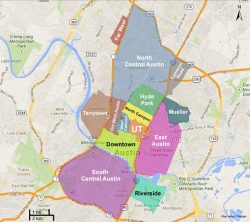
The center of town, which is comprised of the Downtown, Central and parts of the East and West regions, are both the most exciting and the most expensive places to live.
For example, Downtown, Bouldin Creek, Triangle State, and Old West Austin are some of the most expensive, oldest, and busiest neighborhoods available, with rents ranging from $1,796 to $2,560. Highland, Brentwood, Rosedale, and East and West Congress are more moderately-priced areas, with the average rent ringing in between $1,150 and $1,530.
As you move outward to the North, Southeast and South Austin regions, things will get cheaper but it’ll become more difficult to find things to do. Parker Lane, Wooten, Hyde Park, and Windsor Park are all on the more affordable spectrum — you can find rent ranging from $935 to $1,074.
Maps of Austin is a great resource for learning about the schools, hospitals, and points of interest in each neighborhood.
Essentially, your decision about where to live will come down to two main factors: the type of people you want to live around and how much you want to pay for rent or a mortgage.
Remember, price isn’t everything. This is especially true when talking about something as important as the place you choose to live. You should also take into account the feel of the neighborhood you’re moving to.
A family-friendly neighborhood in a good school district is a must for parents with young children. And while job opportunities are plentiful thanks to Austin’s strong job market, you’ll want to ensure a decent commute for yourself as well. Driving from the Texas Hill Country to East Austin for work every day may be more time-consuming than you might expect!
Where in Austin are people like me living?
Everyone wants to live near people they relate to and Esri’s Zip Tapestry tool has made it incredibly easy to find areas with like-minded neighbors.

To demonstrate, when you plug in the zip code for Bouldin (78704), you get a detailed description of the three main demographic groups living in the area.
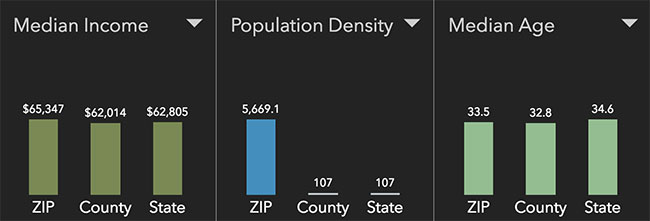
Whether you like your neighbors or not, you’ll all need to know how to get to work on time, so you’ll have that to agree on.
On that note, let’s take a look at the transit options in Austin.
Commuting in Austin
Everyone thinks their particular city has the absolute worst traffic imaginable. Austin has its fair share of traffic, but then so do most major metropolitan areas.
Driving in Austin isn’t great, but commute times are still fairly average. Still, Austin isn’t without its own traffic-related quirks. I-35 can get congested and is a common object of complaint among locals and transplants alike.
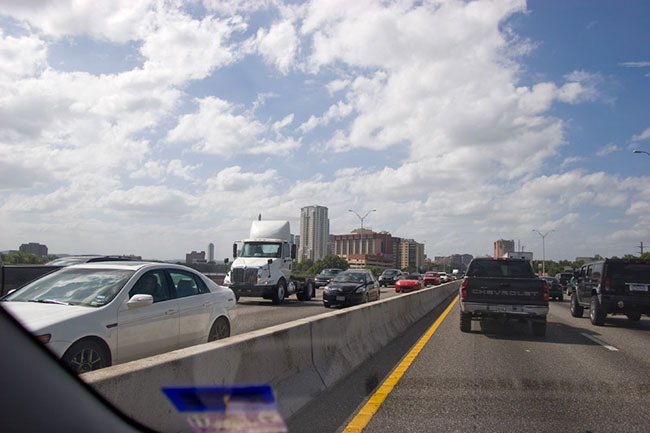
Fortunately, the city recognizes this, and improvements to I-35 are in the works.
Other than that, you have your typical rush hours that can cause delays ranging from 30 minutes to an hour — nothing out of the ordinary for a big city.
In Austin, it’s also particularly important to keep an eye out for pedestrians and cyclists. This is an extremely active city, and you’ll run into people jogging and pedaling everywhere (much more than in many other cities).
Walking, bussing, and biking in Austin
While there are some areas of Austin that are fairly walkable, the city as a whole is pretty car-dependent.
Now let’s talk about being the pedestrian. While there are some fairly walkable areas of Austin, the city as a whole is pretty car-dependent.
A Walk Score of 42 isn’t terrible, but it could be better. Basically, unless you plan to live downtown or near the University of Texas at Austin, you’ll probably want a car.
The bus system isn’t great
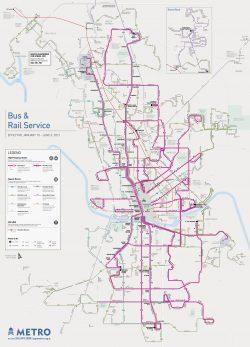
The public transportation system in Austin is … lacking. With a transit score of only 35, it’s hard to recommend this as an option for everyone.
This score essentially means that while Austin has a transit system, it isn’t particularly useful unless you’re using it strictly in the Central and Downtown regions.
Alternatively, Capital MetroRapid (CapMetro) provides a slightly more reliable (but also more expensive) means of getting to, from, and around Downtown.
Austin is totally bikeable, though

Check out the city of Austin’s interactive bike map above ⬆️
Check out the city of Austin’s interactive bike map above ⬆️
One of Austin’s best commuting options is the humble bicycle. This is probably due to the fact that, like we said before, Austin is an extremely active city.
The community’s avid enjoyment of the great outdoors led the city to develop a decent bike trail infrastructure for cyclists, earning the city a bike score of 54.
Along with their numerous bike paths, Austin also offers BCycle, an affordable bike-sharing program.
The crime rate in Austin is average
It’s important to look at the crime statistics of any major city with an analytic eye.

According to NeighborhoodScout, Austin has a crime score of 5 (100 is safest). That isn’t very encouraging, but when you look closer at the data, you see that property damage and theft make up the majority of total crimes committed annually, while violent crime only accounts for about 12% of those crimes.
So keep in mind that “crime” doesn’t always equate to physical danger. As long as you stay aware of your surroundings and don’t actively seek out trouble, it’s pretty easy to avoid bad situations. As with many other major cities, the most dangerous areas tend to be located closer to the city center, with crime rates dropping as you move farther away.
Finding an apartment in Austin
Still with us? Good, because now that we’ve covered the basics of what Austin has to offer, it’s time to get into actually finding a place to live.
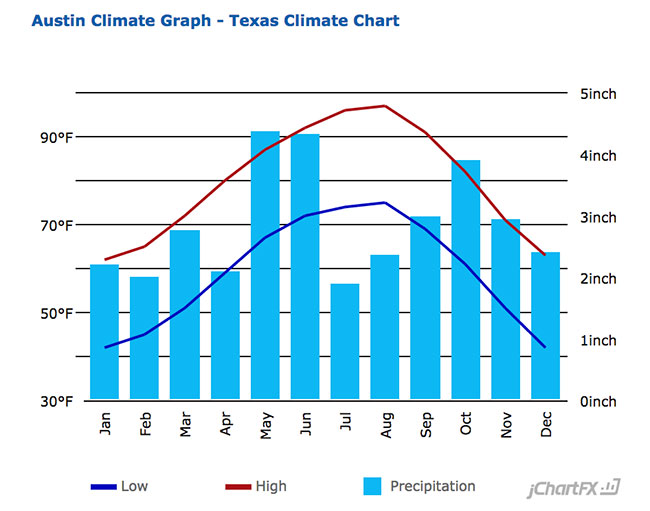
Let’s start by looking at apartments for those who plan on renting.
Austin is located in Central Texas, and as you probably know, the state of Texas gets hot. But on the other end of the spectrum, temperatures can actually get pretty chilly during the winter, particularly at night.
Because of this, you’ll definitely want an apartment with a robust heating and air-conditioning system. And the city’s poor walkability means you’ll also want a place with a washer and dryer.
You’ll also need to consider the average local price of utilities like internet and electricity so you can budget accordingly.
Where to look for an apartment in Austin
Here’s a selection of some of our go-to apartment hunting sites. Each one offers search functions that help you narrow down your search by budget, desired number of bedrooms, etc.
Note: Although Craigslist can be a very useful site for finding apartments, this DOES NOT mean you should trust Craigslist implicitly. Here’s their own guide on how to recognize potential scammers.
- Zillow
- Zumper
- PadMapper
- Craigslist
Austin’s rental market
Living in Austin isn’t as affordable as it once was, but in comparison to similar cities, it’s not the worst place to rent..
From June 2022 to July 2023, rent in Austin actually decreased by 3.9%, while the state and national averages saw prices remain more or less the same.
However, this decrease comes after several years of price increases, and Austin currently has the 32nd-highest median rent prices in the country. And a low vacancy rate of 6.2% means there’s still plenty of competition for apartments and housing.

Image from: Apartment List
Texas rental law
If you plan on renting, it’s important to know your rights so you can avoid being taken advantage of. Here are some quick links to help:
- Texas landlord/tenant laws
- How to file a lawsuit against your Texas landlord
- Texas tenant rights to “repair and deduct”
Finding a home in Austin
In May 2023, the median sale price for homes in Austin, TX was $574,000 — well above the national average. Austin’s housing market is pretty competitive, which leads many new residents to look for housing farther from the city center.
The property taxes in Texas are also higher than average, but this can be slightly offset by the fac that Texas has no state income tax (a big plus if you’re moving from someplace like New York or California).
Fortunately, there are plenty of solid suburbs with decent home prices surrounding Austin that provide great spaces for families to grow without getting bored.
Liberty Hill
This affordable rural neighborhood will remind you that you’re still in Texas without losing the trademark Austin “weirdness.” The area is full of outdoor activities, reasonably priced single-family homes, and numerous local shops and restaurants, allowing you and your family a great quality of life.
Other affordable suburbs: Hutto, Lockhart
Georgetown
Historic Georgetown is a somewhat pricier option, but the upcharge comes with more cultural attractions, plenty of art and culture, and a tight-knit community feel. With real estate options ranging from single-family homes to historic Victorians, Georgetown is the perfect “Austin-adjacent” neighborhood.
Other great Austin suburbs: Lakeway, Round Rock
Nightlife in Austin
We wouldn’t be surprised if the nightlife in Austin is a big part of why you’re considering moving here in the first place. Austin’s biggest draw is its unique music, trendy food scene, and plentiful bars. With a city this jam-packed with things to do, it can be hard to know where to start!
Bars
Like most college towns, Austin loves its bars and breweries. And with such a wide-ranging community, you have endless options for atmospheres in which to drink.
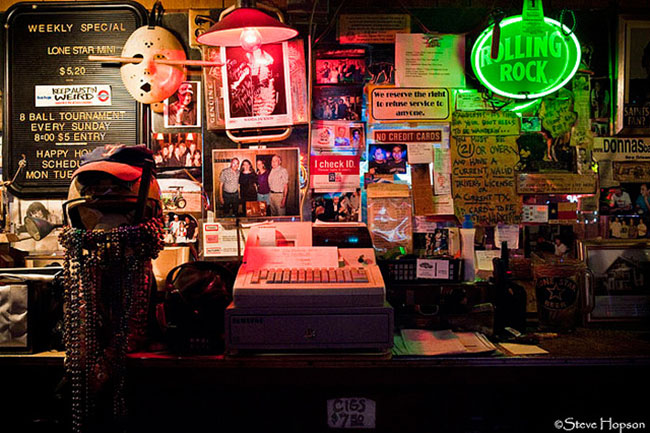
For those who prefer dive bars, Deep Eddy Cabaret is a local favorite with a neighborhood watering-hole feel.
Beer aficionados can head over to Craft Pride for one of the widest selections in town, including a whopping 50 taps dedicated solely to beers brewed in the Lone Star State.
Finally, those in the mood for a night of classy cocktails should look no further than the carefully-crafted concoctions at Half Step.
The live music capital of the world
Austin is famously a live music fan’s paradise, but the amount of genres, musicians, and music venues can be pretty overwhelming.

With a music scene this big, we couldn’t possibly cover it all here. Everyone’s musical tastes vary, but Austin truly has something for everyone. Here’s the city’s official resource for finding music in Austin.
Eating, playing, and keeping Austin weird
Having fun in Austin isn’t limited to the nightlife. Here’s a quick look at some of the best of what Austin has to offer!
Food
If you’re not in Austin for the music, then you’re probably here for the food. Similar to other Texan cities like Dallas and San Antonio, Austin loves their Tex-Mex, breakfast tacos, and BBQ. Eater Austin has a good tool for finding the most popular spots in town. You can also check out this list of the best BBQ in Austin, as determined by the area’s experts.
Beyond the sheer scope of great restaurants, Austin has a thriving food truck scene that offers a whole world of flavors. Parks like The Picnic are dedicated to hosting food trucks, making them a great gathering place for foodies.
Coffee
Whether it’s the abundance of young professionals from up-and-coming tech companies needing a caffeine fix or just your average joe looking to fill up a cup, Austinites love their coffee shops.
Nature
Outdoorsy types who love hiking, biking, and swimming will also find a lot to love in Austin’s great parks and swimming holes. Sites like the Hamilton Pool Preserve, Zilker Park, and Barton Springs Pool all benefit from the year-round balmy Texas weather. You can go kayaking or paddleboarding around Lady Bird Lake, hiking along the Barton Creek Greenbelt, or ziplining at Lake Travis.
Festivals
Austin’s bustling entertainment scene has made it one of the de-facto cities for film and music festivals in the U.S. Massive cultural events such as South by Southwest (SXSW) and the Austin City Limits (ACL) Music Festival have really put Austin on the map! There are multiple musical festivals nearly every month, so click here for more details.
A few more things to consider before moving to Austin
No matter where in the Austin area you end up, there are a few things you’ll need to plan for to ensure your move goes smoothly.
Parking permits for moving vehicles
If you’re moving to Austin, you’ll want to make sure you and/or your movers have a place to park on moving day.
In Texas, residents are required to apply for a temporary parking permit before parking moving vehicles on residential streets. Click here for more information about getting a permit.
Your post-move checklist
Once you’re an official Austinite, there are some details you’ll want to take care of to make a successful transition to your new city.
- Register to vote: For info on registering to vote in Texas, go here.
- Get your driver’s license: Click here to find out how to obtain a Texas driver’s license.
- Register your vehicle: If you’re bringing your car with you, here’s where you can get new plates.
- Take care of your trash and recycling: Go here to set up city trash and recycling services for your new home.
- Meet new people: Making connections in a new city can be difficult. Fortunately, the internet makes connecting with people who share common interests much easier. Meetup.com is a great place to find groups and activities, and r/Austin is a solid resource for staying up-to-date on what’s going on around town.
Now that you’re ready to move to Austin…
Moving to Austin, TX can be an exciting adventure! Whether you’re a music lover or an outdoorsy type, this city has a lot to offer. But to enjoy your new life in Austin to the fullest, you first need to know how to get there.
Fortunately, we have you covered. Use our moving cost calculator to estimate your moving costs to Austin, or check out a more detailed guide about moving to Austin from various cities across the country. Our long-distance relocation guide has even more info and tips to help your move go smoothly.
Finally, if you’re moving locally, you can find great local Austin movers with reviews here.
Okay, that’s all. Now go enjoy some music and BBQ!
Not what you were looking for?
Check out other categories that can help you find the information you need!




